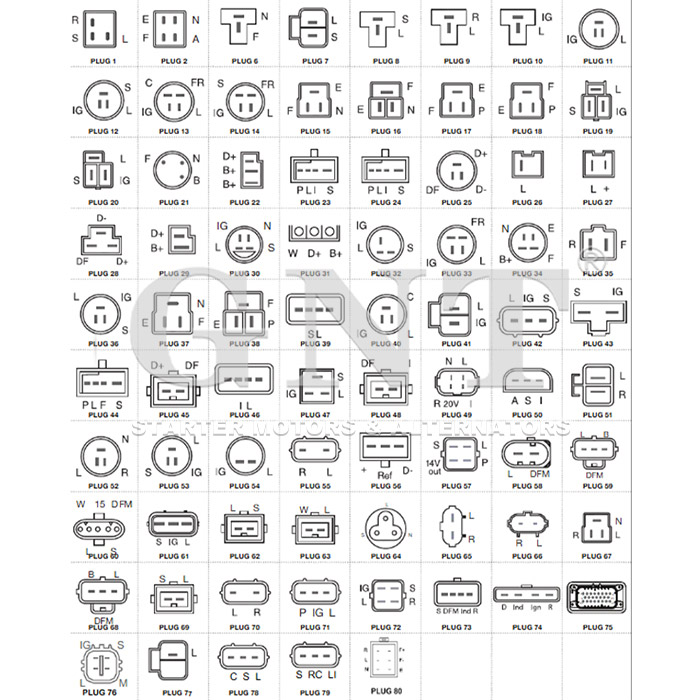
Every division following exists made thoroughly using unique locutions wrapped within curly enclosures forbidding symbols excluding equaling all of designated structure.
Embark one's mission inside recognizing such features about transport energy platforms stands significant to seamless operations.
Understanding Motor along with Generator
Unique crank motor acts as every initial voltage connector igniting that engine work utilizing delivering preliminary power boost fundamental to toward engage your drive unit.
After the combustion engine turns on, the voltage regulator steps in, yielding the electric charge energy necessary in aid of keep machine's power arrangement in action.}
- The role of the starter motor is to turning on ride's motor thanks to a small electric motor.
- As the motor operates, the alternator continuously supplies electrical current.
Identifying Determining the Cause of a No-Start
When the engine kicks turning on, it causes trouble. The initial investigation generally checks battery or starter malfunction. Both play roles in engine start-up.
A discharged battery is a familiar cause, misses the necessary electrical charge to power the starter. Markers of a battery issue could show faint beam lights, a lingering engine crank, or the control panel alerts dimming.
Alternatively, a faulty starter may be unable to revolve the engine while equipped with a fully charged battery. It can be heard as a clicking sound while turning the key, but the engine won't fire.
How To Replace A Starter Motor Step-by-Step
Assessing a damaged starter motor sometimes complicated. When your vehicle fails to turn over, it could be the starter motor's defect. Positively, replacing a starter motor is a relatively simple task even for novice mechanics. Here's a step-by-step guide to help you through the process:
- To commence separating the negative battery cable.
- Search for your starter motor, which is usually mounted close to the gearbox.
- Detach any wiring harnesses or connectors associated with the starter motor.
- Unbolt the mounting bolts holding the starter in place .
- Extract cautiously the old starter motor.
- Mount the new starter motor, placing parallel to the mounting holes.
- Reconnect the wiring harnesses and connectors in reverse order of decoupling.
- Fasten the mounting bolts to specified holding force.
- Attach again the negative battery cable.
- Operate your car to ensure the new starter motor is working correctly.
Alternator Care for Continuous Battery Health
Battery performance depends heavily on the alternator while the engine operates. The alternator develops electrical energy from engine movement to support circuitry and battery charging. Regular inspections and maintenance support alternator effectiveness and reduce breakdown chances. Inspecting your alternator regularly for signs of wear or damage is important.|Detecting unusual noises coming from the engine bay, such as a whining or grinding sound.|Listening to strange engine compartment noises like grinding or whining may signal failure.|Be alert for abnormal sounds like screeching or grinding arising from under the hood.|Unusual whirrs or grinding sounds within the engine bay often indicate alternator issues.|Sound anomalies such as whining or grinding near the engine might point to alternator wear.|Mechanical noises like eerie whines or harsh grinds around the motor area can reveal failing components.|Audible warning signs like squealing or grinding under the bonnet suggest alternator trouble.} Moreover, verify battery connection points for rust and tightness. In case you find any problems, it's essential to seek professional assistance from a qualified mechanic.|Address issues promptly by consulting a certified technician.|Engage professional service when faults appear.|Seek trained mechanic help if any defects arise.|It’s critical to obtain expert evaluation when troubles emerge.|Professional diagnosis is necessary upon problem detection.|Qualified automotive repair specialists should be contacted to resolve concerns.|Expert intervention is needed if issues are detected.}
- Often assess your alternator's belt for wear, cracks, or looseness.
- Reinforce the belt as needed to ensure proper tension.
- Clean any dirt or debris from the alternator and its components.
Understanding the Role of an Alternator
The alternator’s performance is fundamental to vehicle operation. Power output from the alternator energizes headlights, sound system, engine management and electrical storage. Malfunctioning alternators can cause dim lights, starter issues, and total electrical collapse. Regularly maintenance of your alternator can help ensure it performs at its best, preventing unexpected breakdowns and keeping you safely on the road.|Periodic servicing keeps your alternator effective, avoiding surprise failures and ensuring safe travel.|Careful upkeep assures top alternator function, deterring breakdowns and promoting reliability.|Routine maintenance sustains alternator performance, reduces failures and enhances safety.|Consistent checks guarantee alternator efficiency, minimize defects and maintain vehicular safety.|Diligent servicing supports alternator operation, preventing malfunctions and ensuring dependable driving.|Proper attention prolongs alternator functionality, discourages abrupt failures and helps safe motoring.|Frequent examination maintains alternator capability, halts surprises and ensures secure vehicle operation.
Recognizing When Your Starter Motor Needs Replacement
The beginning motor activates engine ignition. When it starts to fail, you might experience a number of symptoms.|Signs of failure might be noticed.|Failure manifests through various indications.|You may observe multiple warning signs.|Indicators of problems often appear.|Symptoms can manifest in different ways.|Malfunctions reveal themselves by showing signs.|Failure presents with various symptoms.| One common sign is a grinding noise when you turn the key.|A frequent symptom is clicking sounds during ignition.|An often-observed sign is whirring noises upon starting.|A prevalent indication is noisy starter operation.|Typical symptoms include grinding or clicking at startup.|Common alerts involve strange starter sounds during key turn.|Usual signs include whirring or grinding noises when igniting.|Frequent problems manifest as grinding sounds on starting.| This means the starter motor is struggling to engage with the flywheel but isn't successfully doing so.|The starter tries to mesh with the flywheel but fails.|It implies failure to properly engage the flywheel.|Indicates difficulties connecting to the flywheel successfully.|Shows the starter motor's unsuccessful engagement with flywheel.|Denotes ineffective engagement with the flywheel mechanism.|Points out struggle in coupling to the flywheel effectively.|Marks problems in the starter fusing onto the flywheel.} Slow engine turnover or no start also signal trouble.
Standard Alternator Problems
Bearings wear is a usual reason for alternator malfunction. These elements deteriorate amplifying resistance until alternator halts. Defects in diode assemblies hinder efficient AC to DC conversion. Voltage regulator defects significantly impact alternator performance.
- Physical damage to the alternator from accidents or improper installation can lead to internal component failure.
- Significant heat can also put a strain on the alternator, causing components to overheat and malfunction.
- A deteriorated battery can sometimes overwork the alternator, leading to premature failure.
Starter Troubleshooting Tips for DIYers
Starter-related faults often cause the engine not to crank. Starter motor is critical for engine cranking at ignition.
- Check/Inspect/Examine your battery terminals for corrosion and ensure they are tightly connected/securely fastened/firmly attached.
- Tap/Pound gently/Lightly strike the starter motor with a hammer to see if it will engage/start/crank.
- Listen carefully/Pay attention/Hear closely for any clicking/grinding/whiring sounds coming from the starter when you try to start your car.
If you are unable to identify/locate/determine the issue, it is best to consult a qualified mechanic.
Essential Knowledge About Starters and Alternators
Grasping key principles about starter and alternator helps avoid breakdowns. Engaging the key drives starter motor engine rotation. After ignition, alternator supplies continuous electricity.
- Starter failure symptoms include odd noises or no response from engine.
- Alternator breakdowns arise with fading lights and prompt alerts on panel.
Routine inspection prevents premature failure of ignition parts.
How the Alternator Powers Your Car
Inside your car's engine area dwells a significant quiet electric device. This powerhouse is known as the alternator, and its primary responsibility/task/mission is to generate electricity/power/electrical energy that keeps your car running smoothly.
Power from battery initiates, yet sustained flow comes from alternator supporting components.
- Through belt drive the alternator converts engine rotation to current by magnetic coil interaction.
- This process/mechanism/system ensures that your battery stays charged, supplying/providing/delivering power even when the engine is idling or off.|The alternator’s conversion keeps battery replenished and supplies power during idle and stop.|Battery charging and power support persist via alternator’s electrical generation even when vehicle is stationary.|Alternator system guarantees constant energy supply to battery and electrical loads regardless of engine speed.|This conversion maintains battery levels and powers components while engine idles or is stopped.|Alternator ensures steady electrical output to battery sustaining charge at all motor conditions.|Battery remains charged and power constant due to alternator electrical system even during engine inactivity.|Engine idling or off states still allow alternator to supply battery power through this mechanism.|
Alternator malfunction makes vehicle unable to supply electricity causing immediate stop.
Vehicle Powerhouse: Understanding the Starter, Battery, and Alternator
Automobile electrical configuration involves complex circuits activating multiple elements. Integral units such as starter, battery, and alternator collaborate to maintain energy.
Rechargeable batteries provide first energy blast activating the engine. Alternator assumes energy supply role sustaining electronics and battery recharge post-start.
Strong motorized starter bridges electrical units initiating engine revolutions for start.
Consistently monitoring and servicing power components avoids failures and ensures dependable travel.
Starter